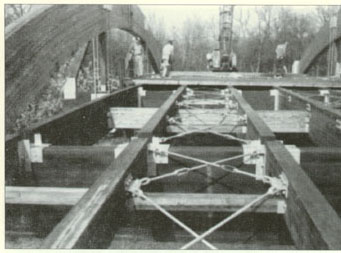
Design professionals translate an owner's expectations into drawings and specifications that are then used by contractors to bid and construct a project. At this location in Grundy County timber was used to complement the historic nature of a replacement bridge over the Illinois and Michigan Canal National Heritage Corridor (Photo is courtesy of the consulting Engineers Council of Illinois 1996 Engineering Excellence Awards program.)
Rebidding works best if the project scope is reduced substantially, if the owner waits at least six months in order to allow changes in the building market or both, Evans explains. Even with those steps, Broeren recounts projects that came in at the original bid price even after a reduction in scope.
Reissuing the same plans soon after the first bid, or making only minor changes creates an unfair bidding climate in which contractors may try to undercut the original low bid. If successful, those contractors may try to cut corners on the job or assign an inadequate number of workers in order to make a profit, Evans says.
Partnering
In the eyes of Bernard I. Jones, president of Garrison-Jones Architects Inc., Carbondale, partnering is a formalized resurgence of the way construction used to be done. During partnering, design professionals, contractors and owners create an atmosphere of mutual trust, develop strategies to achieve their project goals, learn the pending challenges and plan avenues to resolve potential problems.
Martin H. Collier, vice president of LZT, Peoria, likens partnering to Total Quality Management, where all parties work together for the project as a whole. When one or more sides "throw up their walls" as a problem begins to arise, communications become stifled, he says. Partnering agreements establish avenues of communication to be followed throughout the project.
Bonczyk says some parties suggest that partnering agreements create a form of third-party liability. From his experience at the Illinois Capital Development Board (CDB), however, this is not the case. He advocates partnering charters that include provisions for alternate dispute resolution. If parties rely on arbitration to resolve disputes, rather than mediation or less formal dispute resolution techniques, Bonczyk says they might as well go to court because lawyers, who generally don't understand construction, enter the picture. "I'm a lawyer, but I hate litigation. It's wasteful," he says.
George Bloome, AIA, PE., president of Ralph Hahn and Associates, Inc., Springfield, also reminds owners that design professionals represent them during construction, so these two parties should have no misunderstandings. Where owners feel contractors have not met their legal obligations, he suggests each party ask objectively what a "reasonable person" would decide.
Tick Tock
Delays are an enemy of construction. Unfortunately, even the most experienced schedulers and computerized scheduling software cannot anticipate every contingency. "Scheduling is not a perfect science," Evans says, and he predicts changes to almost every project schedule as all parties have an input on schedule modifications.